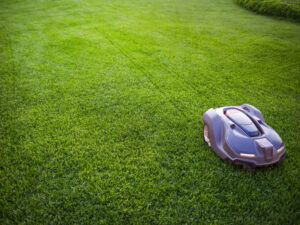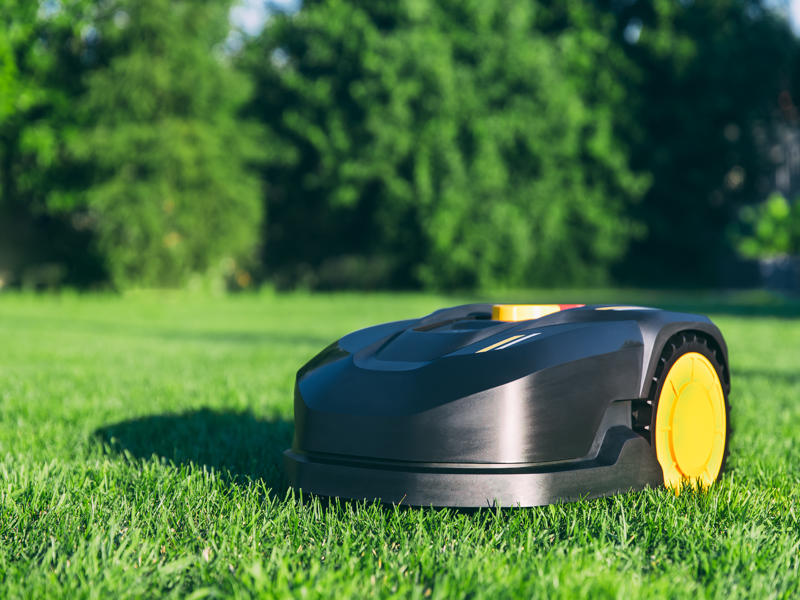Are you asking yourself the question, What Is A Robotic Lawn Mower? That’s exactly what we’re going to discuss here but first let us paint a picture for you.
Have you ever dreamed of having a magical lawn care buddy that can mow your lawn like a pro, whenever you want, while you sit back and sip on your lemonade? Well, aside from lawn professionals of course.
No worries, we get it. Sometimes you don’t want strangers around your home, even if they are a professional service like us at United Family Lawn Care Services.
Well, get ready to have your curiosity tickled and your lawn pampered, because have we got a treat for you! We’re about to introduce you to the delightful world of robotic lawn mowers!
What Is A Robotic Lawn Mower?
(Click Here To See A Robotic Lawn Mower in Action!)
A robotic lawn mower, also known as an Automower, is an autonomous and self-propelled machine designed to mow grass without human intervention. It operates on rechargeable batteries and uses advanced technology, such as GPS (Global Positioning System), sensors, and programming, to navigate and maintain a lawn. These intelligent devices tend to be programmed to follow a specific mowing pattern, ensuring the entire lawn is evenly and consistently cut.
What Are The Features of Robotic Lawn Mower:

- GPS-Assisted Navigation: This technology enables the mower to create a map of the lawn and navigate in a systematic pattern, ensuring comprehensive coverage.
- Boundary Wire: A boundary wire is installed around the lawn’s perimeter, acting as a virtual fence to guide the robotic mower and prevent it from wandering into areas it shouldn’t mow.
- Sensors: The mower is equipped with various sensors, such as lift and tilt sensors, to detect and avoid obstacles and potential hazards.
- Programmable Schedule: Users can set specific mowing schedules based on their lawn’s needs, including the frequency and duration of mowing sessions.
- Rechargeable Battery: The mower operates on battery power and automatically returns to its charging station when the battery needs recharging.
- Mulching Blades: Robotic lawn mowers use mulching blades to finely chop grass clippings, which are then left on the lawn as natural fertilizer.
- Mobile App Compatibility: Many models come with mobile app integration, allowing users to control and monitor the mower remotely using their smartphones.
We understand that time is of the essence, so if you’re in a rush, checkout the link below to see our #1 Recommended Robotic Lawn Mower. Or keep reading to stay well informed!
Click Here To Learn More About Our #1 Recommended Robotic Lawn Mower!
Types of Robotic Automowers
Robotic Automowers come in various types, each designed to cater to different lawn sizes and specific needs. Here are some of the common types of robotic lawn mowers available:

- Small Yard Robotic Mowers: These models are designed for small lawns, usually up to 1/4 acre in size. They are compact and lightweight, making them ideal for maneuvering through tight spaces and narrow passages.
- Medium Yard Robotic Mowers: Suitable for medium-sized lawns ranging from 1/4 acre to 1/2 acre, these mowers offer more power and cutting capacity than their smaller counterparts. They can handle more challenging terrains and have longer battery life.
- Large Yard Robotic Mowers: As the name suggests, these robotic mowers are built to tackle larger lawns, typically ranging from 1/2 acre to 1 acre or more. They are more robust, have larger cutting decks, and longer battery life to cover expansive areas efficiently.
- Self-Installing Robotic Mowers: Some robotic lawn mowers offer a self-installation feature, where users can easily set up the boundary wire and docking station without the need for professional assistance. This convenience makes them a popular choice for DIY enthusiasts.
- Smartphone App-Controlled Robotic Mowers: Many modern robotic mowers are equipped with smartphone app compatibility, allowing users to control and monitor their mower remotely. Through the app, users can adjust mowing schedules, cutting heights, and receive real-time status updates.
- Mulching Robotic Mowers: Most robotic lawn mowers are equipped with mulching capabilities, meaning they finely chop grass clippings and leave them on the lawn as natural fertilizer. Mulching promotes a healthier lawn by returning valuable nutrients to the soil.
- Rain-Sensing Robotic Mowers: Some advanced models come with rain sensors, allowing them to pause mowing sessions during wet weather to avoid damaging the lawn and conserving energy.
- GPS-Assisted Robotic Mowers: Robotic mowers with GPS-assisted navigation can create a virtual map of the lawn, ensuring systematic mowing and efficient coverage.
- Slope-Adaptive Robotic Mowers: Designed for lawns with steep inclines, these mowers can navigate and mow on uneven terrain without compromising performance.
- Quiet Robotic Mowers: Many robotic lawn mowers are engineered to operate quietly, producing minimal noise during mowing sessions, making them suitable for use during any time of day.
- Automatically Scheduling Robotic Mowers: These mowers can analyze the lawn’s growth rate and automatically adjust their mowing schedule accordingly, ensuring the lawn remains well-maintained without any manual intervention.
When selecting a robotic lawn mower, it’s essential to consider your lawn size, terrain, and specific requirements to find the perfect match that will keep your lawn looking lush and healthy with minimal effort.
What Are the Safety Features for Robotic Lawn Mowers?
Robotic lawn mowers are designed with several safety features to ensure safe and worry-free operation. These features aim to protect users, pets, and the mower itself from potential hazards. Here are some common safety features found in robotic lawn mowers:
- Obstacle Detection Sensors: Robotic mowers are equipped with various sensors, such as ultrasonic, infrared, or bumper sensors, to detect obstacles in their path. When the mower senses an object, it will automatically change its direction to avoid collisions.
- Lift and Tilt Sensors: Lift sensors detect when the mower is lifted off the ground, such as when someone picks it up. Tilt sensors activate when the mower tilts or flips over. When either of these events occurs, the mower’s blades automatically stop to prevent injury.
- Virtual Boundaries: Robotic mowers operate within predefined virtual boundaries, set up using a boundary wire or GPS-assisted navigation. These boundaries prevent the mower from leaving the designated mowing area and potentially venturing into hazardous areas.
- PIN Code or Touch ID Lock: Some models offer PIN code or touch ID locks, ensuring that only authorized users can access the mower’s settings or control functions.
- Automatic Shut-Off: Robotic mowers have an automatic shut-off feature that stops the blades and motor when the mowing session is complete, or the battery needs recharging.
- Rain Sensors: Certain models are equipped with rain sensors that detect wet weather conditions. When rain is detected, the mower will automatically pause its mowing session and return to its charging station until the weather improves.
- Anti-Theft System: Some advanced robotic mowers feature an anti-theft system that requires a unique code to start the mower. If the mower is moved or stolen, it will remain inactive without the correct code.
- User-Defined Safety Zones: Users can program safety zones in areas where additional precautions are required, such as near swimming pools or children’s play areas. The mower will slow down or avoid these zones altogether.
- Blade Safety Mechanisms: Robotic mowers use retractable blades that automatically stop when they encounter resistance, reducing the risk of injury.
- Automatic Charging: When the battery level is low, the robotic mower automatically returns to its charging station to recharge, ensuring it’s ready for the next mowing session.
These safety features work in conjunction to create a safe and reliable lawn care experience, giving users peace of mind while their robotic lawn mower efficiently maintains their lawn. However, it’s essential to follow the manufacturer’s guidelines and safety recommendations to ensure proper usage and safe operation of the mower.
The key advantage of a robotic lawn mower is its ability to take care of lawn maintenance with minimal human involvement.
By autonomously mowing the lawn, these machines save time and effort for homeowners, providing a well-maintained lawn throughout the mowing season. Additionally, their low noise level and eco-friendly operation contribute to a peaceful outdoor experience and a greener environment.
I hope that you’ve found value in this information. If you have any questions, comments or other feedback please leave them in the comments below.
If you are looking for The Best Robotic Lawn Mower, the one that us as lawn care professionals since 2015, recommend to anyone looking into Automowers, click the button below to learn more! See you next time 🙂

As someone who is new to the concept of robotic lawn mowers, I find the idea of having a self-propelled lawn care buddy quite fascinating.
However, I’m curious about the installation process and whether it’s easy for beginners like me to set up a robotic lawn mower in their yard.
My question to you are:
– How easy is it for a beginner to install a robotic lawn mower in their yard?
– Are there any specific tools or technical knowledge required for the installation, or is it a straightforward process that can be done without professional assistance?
– Additionally, how long does the typical installation take, and are there any common challenges that beginners might face during the setup?
I appreciate the detailed explanation of the features and safety aspects of robotic lawn mowers, but I want to ensure that I can easily set up and start using a robotic lawn mower without any major difficulties.
Thank you for sharing this informative article, and I look forward to learning more about this innovative lawn care solution!
Hey there!
Thanks for leaving your comment and questions. Yes there is a setup process but honestly it depends on the unit.
Some run by using wires buried in the ground and some have a barrier they operate within.
Remember, if you ever have any difficulty with installation you can get expert advice or opinion from your local lawn care service providers.
We really appreciate your questions and will be providing the answers in subsequent posts so keep any eye out for them!
Take care,
Marlinda
Hi there,
I enjoyed reading your article about robotic lawn mowers. It’s clear that you have a lot of knowledge and experience in this area.
I’m particularly interested in the safety features that you mentioned. It’s reassuring to know that these machines are designed with such care to prevent accidents.
I’m also impressed by the environmental benefits of robotic lawn mowers. Their low noise level and eco-friendly operation are a big plus.
Hey Jeffrey!
We have a Jeffrey on our team too! haha! Its always nice to come across people with the same names, hehe.
We’re glad you found this information helpful and found value in it.
Thanks for leaving such a lovely comment.
Take care and have a safe and blessed night,
The Lawn Whisperers
Your posts stand out from other sites I’ve read stuff from. Keep doing what you’re doing!
Hey there,
We’re glad you found value in this info.
Take care,
The United Family Lawn Care Team
Hey Davida,
We’re so glad you found value in this information.
Please reach out if you have any further questions or concerns.
Take care,
The United Family Lawn Care Team
Hey Khalani,
We’re so glad you found value in this information.
Please reach out if you have any further questions or concerns.
Take care,
The United Family Lawn Care Team